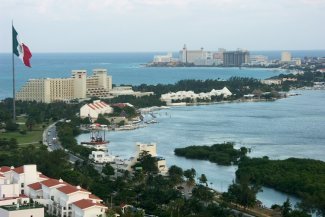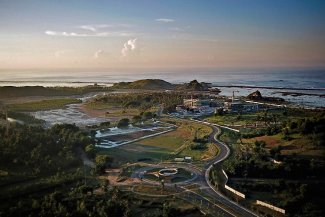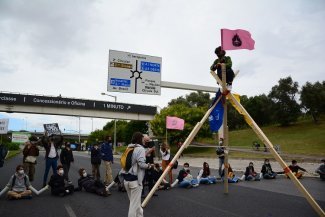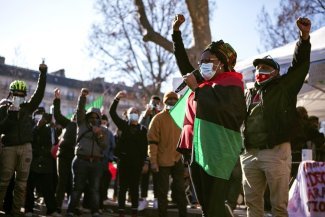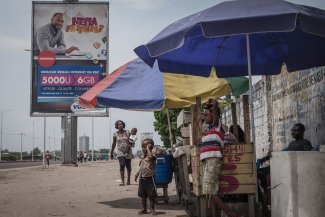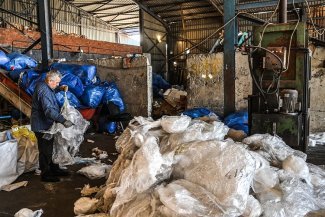A group of environmentalists protest against the environmental and cultural destruction caused by the Tren Maya works. Playa del Carmen, Mexico, 6 March 2022.
Mexican President Andrés Manuel López Obrador’s dream legacy is the Tren Maya (Maya Train), a passenger and freight railway network that will traverse the Yucatán peninsula.
This is a mega infrastructure project of the highest calibre, with over 1,550 kilometres of railway track set to cross five states in the south-east of the country – Chiapas, Tabasco, Campeche, Yucatán and Quintana Roo – 21 stations, 14 stops and an investment of almost 200 billion pesos (around US$9.8 billion, €8.73 billion).
López Obrador has called for the pace of the works to be accelerated. He wants to inaugurate the train in December 2023, almost a year before the end of his term, and for it to be part of his administration’s main infrastructure legacy alongside Mexico City’s new international airport.
The president is convinced that the train will help pay off the “historical debt with the south-east” of the country, an area lagging behind in terms of economic development compared to the industrialised states of central and northern Mexico.
But not everyone shares his enthusiasm. Indigenous communities and environmental organisations are staunchly opposed to the project, given the catastrophic environmental impact it will have on an area rich in biodiversity and crucial to the conservation of the Mayan rainforest.
The railway line will pass through the Calakmul Biosphere Reserve, which has the second largest expanse of tropical forests in the Americas, and eight other important nature reserves, such as Sian Ka’an and Yum Balam, both in Quintana Roo.
There are also strong concerns over the damage to archaeological sites and the project’s failure to respect environmental legislation, with environmental impact assessments either not made public or only presented once the works are already underway.
Mayan opposition
One of the ironies of the megaproject is that despite bearing the name ‘Maya’, a large part of the Indigenous communities in the Yucatán peninsula are opposed to it.
“From the very start, we said that it was not ours, that it is a project that goes against the Mayan peoples and we cannot accept something that will bring harm to our lives,” Pedro Uc, a member of the Assembly of Mayan Territory Defenders, Múuch’ Xíinbal, tells Equal Times.
The assembly, founded in 2018, brings together some 25 Mayan communities that have organised to fight against megaprojects in the Yucatán peninsula and have filed several injunctions to halt the Tren Maya works. The first relevant victory in the courts occurred in the first week of March 2022, when a federal court ordered a halt to the works on the first three sections of the train, which go from Palenque (Chiapas) to Izamal (Yucatán). Despite this, however, López Obrador announced that the work will not stop because the sentence must still be reviewed by the Supreme Court.
According to Uc, the train is an “attack” on the environment and Mayan identity. “When you destroy territory, you destroy a way of thinking, a way of seeing, a way of life, a way of explaining the reality that is part of our identity as Mayan peoples,” he says.
He also criticises the fact that the project has gone ahead with its back turned on the Indigenous communities that live in the area, despite the Indigenous consultation that took place at the end of 2019 (a consultation that was questioned by the Office of the UN High Commissioner for Human Rights, UNHCHR).
“We took part in this process as observers and we realised how spurious it was, how much propaganda there was about the train. Very few people took part and it has no legitimacy because the ballot paper featured a list of the benefits that the project would bring but didn’t mention any negative impacts,” says the activist, who claims he received death threats for his opposition to the train.
The Mayan communities feel betrayed by López Obrador, to whom they handed over the leadership baton during his inauguration in 2018, and now they are being “batoned” by the authorities.
Uc stresses that Mayan communities are not opposed to development and advances in society. “We don’t want to go back to wearing loincloths and feathers,” he says. But nor can they stand idly by in the face of an initiative that represents a fierce attack on their territory. “A project like this inevitably implies the crushing of our communities to allow other ways and other interests to take over the area,” he insists.
What about environmental law?
Since the president announced the Tren Maya project in December 2018, numerous allegations of administrative irregularities have emerged.
Xavier Martínez, operations director at the Mexican Centre for Environmental Law (CEMDA), tells Equal Times that the project’s environmental risks are “absolutely uncertain” because the authorities have failed to present a full assessment. Instead of presenting an Environmental Impact Assessment (EIA) for the construction of the entire railway, the National Fund for Tourism Development (Fonatur), which is in charge of the works, divided the project into seven sections. This led to a dispersion of the bureaucratic procedures, as it meant that an environmental impact assessment was required for each individual section, ruling out any possibility of measuring the “cumulative or synergistic impacts” of this type of megaproject on ecosystems, according to the head of CEMDA.
It also gave rise to violations of the legal framework, such as the start of works on several sections before the environmental impact studies were approved by the Secretariat for the Environment (Semarnat).
This obscurantism has also been encouraged by López Obrador, who, in November 2021, declared that the government’s main infrastructure projects were considered matters of “national security”.
This controversial measure gives the authorities the power to speed up certain procedures, obliges them to grant permits and licences within five days and allows them to extend provisional construction permits so that work on the government’s priority projects is not halted.
CEMDA has filed three injunctions against the railway project, but so far has only obtained a small victory with one of them – a precautionary measure that forced work to stop on a small 235-kilometre stretch between Escárcega and Calkiní, in Campeche.
The legal challenges to the project have met with endless hurdles. The latest blow was Fonatur’s request for all injunctions against the Tren Maya project to be concentrated in a single court. The Supreme Court approved the request and all the injunctions are now in the hands of a magistrate in Yucatán. “Imagine the pressure that court will be under. We won’t have a diversity of rulings or arguments now,” laments Xavier Martínez.
Archaeological risks
At the end of February of this year, Mexico’s supreme audit institution, the ASF – a specialised body of the Chamber of Deputies that audits the use of public resources – published a damning report on the Tren Maya project.
The ASF warns of the archaeological risks involved in the rush to complete the works: “With regard to archaeological excavation, the ASF audit group has identified risks related to the time needed for archaeological salvage procedures.”
This salvage work is in the hands of archaeologists from Mexico’s National Institute of Anthropology and History (INAH), who are exploring the paths along which the tracks of the Maya Train will run, equipped with state-of-the-art technology.
Their mission is to rescue the remains, clean and restore them in laboratories, study them and return them to the site where they were found. Those found on the route of the future train tracks will be relocated to another area.
In the first section of the train’s route alone, a stretch of around 228 kilometres between Palenque (Chiapas) and Escárcega (Campeche), 2,482 structures, 80 burial sites, 60,000 ceramic fragments and 30 complete vessels have already been identified, according to the INAH report published in October 2021. The study of these finds will provide details about the pre-Hispanic occupation of these areas, from the Middle Preclassic (700-300 B.C.) to the Late Classic period (600-850 A.D.).
Support from the tourism sector
Neither the criticism from activists and environmentalists nor the images of bulldozers razing hectares of jungle have made a dent in the Mexican president’s determination to forge ahead with the Tren Maya project. López Obrador is keeping a close eye on its progress, flying over parts of the construction site by helicopter every few weeks. In January of this year, he replaced the head of Fonatur with a more trusted colleague, because he felt the work was not progressing at the right pace.
On the Tren Maya website, Fonatur points out that development has not reached the Yucatán peninsula at the same pace as in northern and central Mexico, largely due to the lack of transport infrastructure and connectivity.
For those heading the project, the railway will stimulate the economies of the five states and the freight transport will give a strong boost to the agricultural, construction materials and fuel sectors.
Those in the travel and tourism industry are also rubbing their hands at the idea of the Maya Train. Mexico’s main tourist attractions, such as the Mayan ruins of Chichén Itzá, the beaches of Cancún and the Riviera Maya, are located on the Yucatán peninsula.
According to figures from the Quintana Roo Tourism Secretariat, the state received 13.5 million visitors in 2021, mainly in Cancun (4.6 million) and the Riviera Maya (5.6 million). In 2019, before the Covid-19 pandemic, tourism accounted for 35 per cent of Quintana Roo’s gross domestic product (GDP). It is also an important source of revenue for the other states through which the Maya Train will pass, such as Chiapas (12.7 per cent of GDP) and Yucatán (11.1 per cent).
Business leaders expect the railway to substantially expand what is already on offer in a part of the country with so much more to show its visitors.
Iván Rodríguez Gasque, president of the National Chamber of Commerce, Services and Tourism in Mérida, in the state of Yucatán, tells Equal Times that the Tren Maya has “incredible tourism potential” for the region, but stresses that there is still much work to be done, especially on the train stations and the “development hubs” that the authorities expect to emerge around them.
The project’s promoters hope that, with the support of the private sector, the railway stations and stops will become the cornerstone of new centres of economic and commercial activity, with new green areas, local services and an increase in the value of property in the area.




